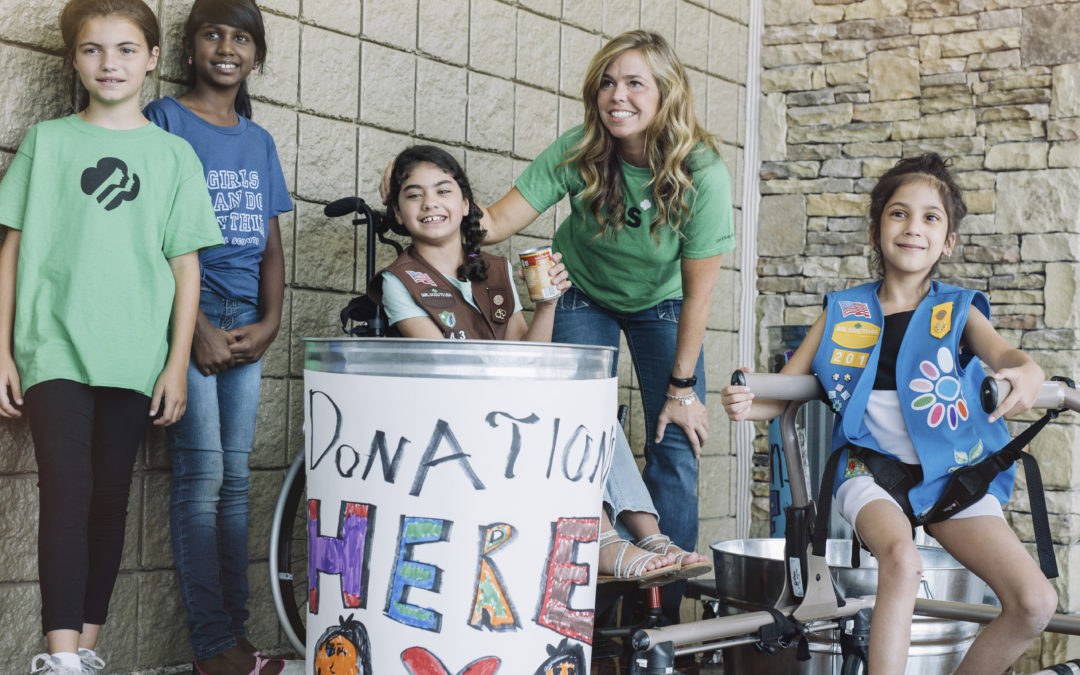If you had to quickly list three things that Girl Scout troops do, what would they be? Cookie sales might make your list. Maybe earning badges or working toward a Silver or Gold Award is high up as well. Perhaps your troop is also into volunteering or camping. Every troop is different—from their priorities to how they structure their meetings to how active they are. But one thing every troop should have in common is living by the Girl Scout Law. The law ends by reminding us to be “a sister to every Girl Scout”—this powerful phrase is a good place to start reviewing the way we plan our activities and run our troops to be more inclusive and welcoming to girls of all stripes.
Pin this post for later!
In today’s world, “diversity” can often seem like a buzzword that’s difficult to fully define. Diversity can refer to race, gender, sexual orientation, ability, class, and countless other factors and identities. The world is full of different people, and it’s important to work toward greater understanding of each other—both those who are like us and those who are not. Spending time with and working alongside people of all backgrounds can be beneficial for everyone. Diverse perspectives can bring diverse ideas, solutions, experiences, and more. Are you making sure that your troop is open to all potential members?
Girl Scouts has a strong history of inclusiveness. The organization always seeks to support its troop leaders and members to accommodate girls of all abilities and to support each member to make the most of her Girl Scout experience. So how and where do you start building a welcoming and inclusive troop?
Building an inclusive Girl Scout Troop seems as though it’s easier said than done. However, according to the U.S. Census Bureau, nearly 1 in 5 people have a disability. This means that around 20% of girls of Girl Scouting age are living with a mental or physical disability.
If you have a troop already, take a good look at your members—literally and figuratively. Do they all look the same? Think the same way? Have the same abilities? Girl Scouts is partially a social activity, yes, but it’s also a great way to teach members about their place in their larger community and in the world.
- If you’re starting a new troop, think about reaching out to potential members from different schools within your district or city, rather than just sticking to the school your daughter attends. Talk to teachers and other parents in your area. They may be able to identify potential members who would love to join your troop if there were fewer barriers to entry.
- Next, you should take a look at the activities your troop does. How could you alter your meetings, events, and trips so that they’re accessible for a member in a wheelchair? A neurodivergent member? A member who is vision impaired or deaf/hard of hearing? You could turn this thinking exercise into a troop activity in itself. Maybe you could seek out campsites on more even terrain, find a meeting location without steps, get a copy of a troop book printed in braille, or a number of other alterations.
- Ask current and potential troop members with disabilities what changes they would like to see, or what they would need in order to be comfortable within your troop. Check in with your troop parents as well to make sure that their daughters’ needs are being met by you, your co-leaders, and the other girls in the troop.
- You should also check the language you use, taking care never to use ableist terms or slurs.
- Once you’ve set the groundwork for a welcoming and accessible troop, be sure to approach all future activities with accessibility at the forefront of planning and decision-making, rather than an afterthought.
- Continue to check out resources on fostering and maintaining inclusion from Girl Scouts across the country, including this video from Girl Scouts of the Nation’s Capital and this handbook from Girl Scouts of Western Washington.
Girl Scouts seek to make their communities a better place for everyone. To maintain the focus on inclusion as you continue to build your troop, make sure to talk about diversity as a greater concept with your Girl Scouts. Invite guest speakers from different backgrounds—different socioeconomic classes, ability levels, sexual orientations, gender identities, etc. Talk about ways that each girl in your troop is different from the other, and help them to recognize that all these differences are normal and something to be embraced and even celebrated.
Disabled girls of all ages deserve a place like Girl Scouts to feel welcome and safe. Teach your troop how to be the inclusive force we all want to see in the world, and they will continue to teach others around them.
 Lia Seth—Lia leads a troop of Ambassador Girl Scouts in Palo Alto and is a Lifetime Girl Scout Member. She is a Bay Area native and works as an HR Generalist. She loves finding and testing new recipes, watching 49ers football, and playing and hosting pub trivia events. Her writing has been featured by Pearson Education, Huffington Post, Buzzfeed, and local NPR radio stations.
Lia Seth—Lia leads a troop of Ambassador Girl Scouts in Palo Alto and is a Lifetime Girl Scout Member. She is a Bay Area native and works as an HR Generalist. She loves finding and testing new recipes, watching 49ers football, and playing and hosting pub trivia events. Her writing has been featured by Pearson Education, Huffington Post, Buzzfeed, and local NPR radio stations.


This wonderfully written blog post made me feel extremely proud to be part of an organization where members pay more than lip service to the concept of inclusivity. It’s a beautiful thing when girls respect each other regardless of differences and focus on what binds them together, while celebrating that which makes them different. I have one more suggestion to offer to cultivate an environment of mutual respect:
Let girls choose whether they are on the “award track”. When girls who are earning Silver and Gold awards have willing assistance from those who don’t choose to earn those awards, they learn to accept and respect the choice not to earn their awards. And girls who aren’t forced onto an award track learn that they can still participate as a full member of a troop and still enjoy the many benefits of Girl Scouting.
I feel that by building that environment, differences in abilities, culture, etc. can be more accepted as well.